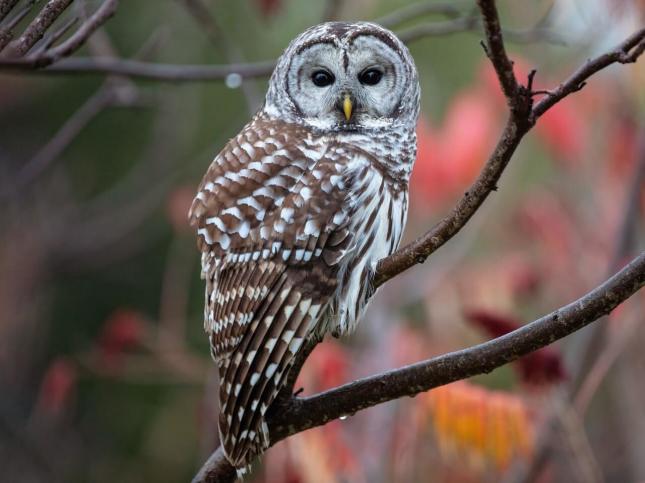
Fun Facts About Barred Owls
- The Barred Owl’s hooting call, “Who cooks for you? Who cooks for you-all?” is a classic sound of old forests and treed swamps. But this attractive owl, with soulful brown eyes and brown-and-white-striped plumage, can also pass completely unnoticed as it flies noiselessly through the dense canopy or snoozes on a tree limb. Originally a bird of the east, during the twentieth century it spread through the Pacific Northwest and southward into California.
- Barred Owls don’t migrate, and they don’t even move around very much. Of 158 birds that were banded and then found later, none had moved farther than 6 miles away. The Great Horned Owl is the most serious predatory threat to the Barred Owl. Although the two species often live in the same areas, a Barred Owl will move to another part of its territory when a Great Horned Owl is nearby.
- Barred Owls live year-round in mixed forests of large trees, often near water. They tend to occur in large, unfragmented blocks of mature forest, possibly because old woodlands support a higher diversity of prey and are more likely to have large cavities suitable for nesting. Their preferred habitats range from swamps to stream sides to uplands, and may contain hemlock, maple, oak, hickory, beech, aspen, white spruce, quaking aspen, balsam poplar, Douglas-fir, lodgepole pine, or western larch.
- Barred Owls eat many kinds of small animals, including squirrels, chipmunks, mice, voles, rabbits, birds (up to the size of grouse), amphibians, reptiles, and invertebrates. They hunt by sitting and waiting on an elevated perch, while scanning all around for prey with their sharp eyes and ears. They may perch over water and drop down to catch fish, or even wade in shallow water in pursuit of fish and crayfish. Though they do most of their hunting right after sunset and during the night, sometimes they feed during the day. Barred Owls may temporarily store their prey in a nest, in the crook of a branch, or at the top of a snag. They swallow small prey whole and large prey in pieces, eating the head first and then the body.
- Barred Owls roost on branches and in tree cavities during the day and hunt by night. Territorial all year round, they chase away intruders while hooting loudly. They are even more aggressive during nesting season (particularly the females), sometimes striking intruders with their feet. Pairs probably mate for life, raising one brood each year.
- The oldest recorded Barred Owl was at least 24 years, 1 month old. It was banded in Minnesota in 1986, and found dead, entangled in fishing gear, in the same state in 2010.

